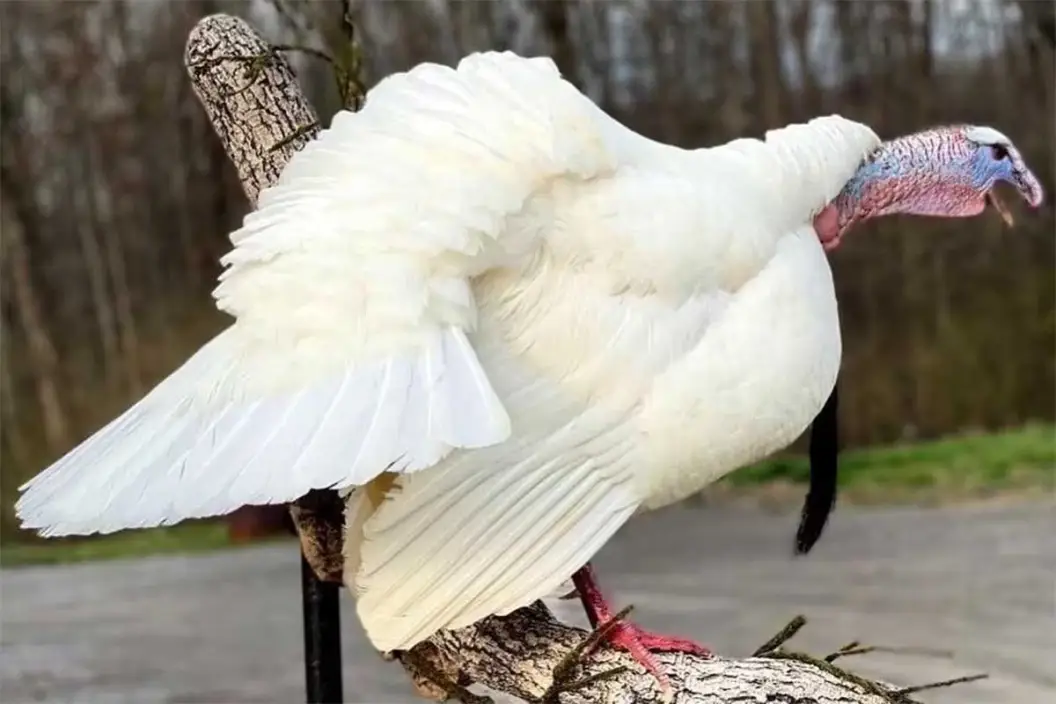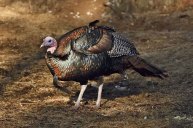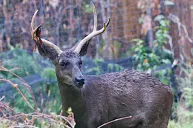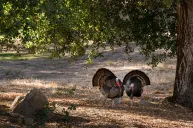As turkey hunters gear up to hit the woods this spring, only a handful will likely experience one of the rarest sights in the woods. That is a sighting of a smoke-phase or white wild turkey.
People seem to shoot a handful of them here in North America yearly. Without fail, the jokes on social media from fellow hunters usually include some farmer being mad because someone shot one of his domestic turkeys that escaped.
Sure, the birds raised by humans are typically white. But there is such a thing as a white wild turkey, although these birds seem extremely rare. Or, at the very least, most are probably picked off by coyotes and other predators when they are still poults because of their lack of camouflage.
Still, on rare occasions, one of these birds survives to adulthood and is harvested during turkey hunting season. Today we'll look at the different color phase turkeys and find out what causes them.
Can a Wild Turkey Be White?
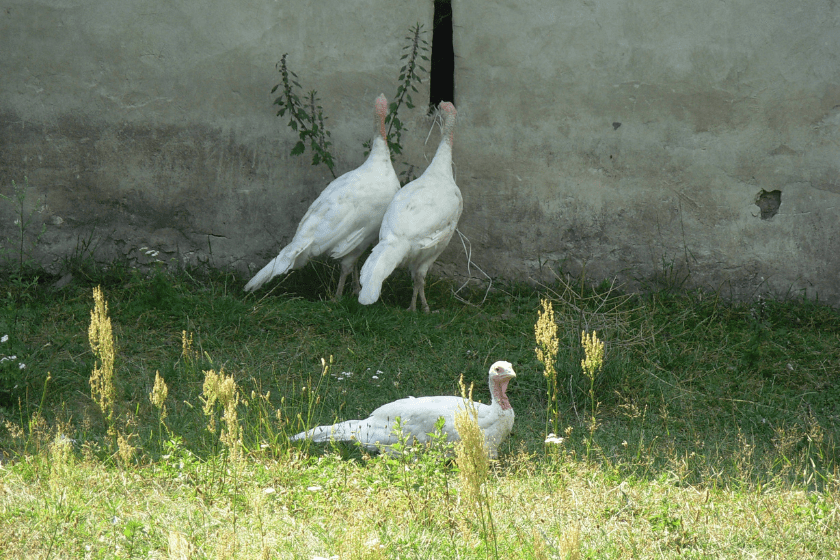
myself (User:Piotrus), CC BY-SA 3.0, via Wikimedia Commons
A wild turkey can have white feathers, and these unusual color phases are usually a result of conditions known as albinism or leucism. These conditions are genetic mutations caused by a recessive gene that leads to a considerable loss of pigment. It's the lack of pigment that sets them apart from normal-colored turkeys.
Note that while humans can develop albinism, they cannot develop leucism. Albinism is an absence of melanin, the source of pigmentation in the skin, eyes, and hair. In leucism, melanin is still present, if only in the eyes. Humans only have one type of skin pigment cell, while animals have multiple. Leucism requires multiple pigment cells. The closest human equivalent to leucism is vitiligo.
According to the National Wild Turkey Federation (NWTF), turkey has several different color phases. They also note scientists have yet to discover the exact causes of this type of mutation. Many people think they result from domestic birds and wild birds cross-breeding. However, scientists are skeptical of this explanation. Even if it were true, that doesn't explain all the white turkeys in the wild.
It's worth noting that identifying a true albino can only be easy with a biologist inspecting the animal. The presence of pink eyes is usually a good indication of albinism. Most white turkeys shot by hunters in the wild are leucistic because this mutation seems to retain pigment in at least some features, especially in the eyes.
In 2020, some hunters harvested a white adult male turkey on public land that they had. nicknamed "The Ghost." This animal had wing and tail feathers that were completely white with no pigment. However, the bird had a normal-colored head and beard.
The smoke-phase seems much more common in most cases than in a turkey with albinism or a leucistic turkey. In this phase, the bird still retains quite a bit of black pigment in its feathers, and the appearance takes on more of a gray or "smokey" look. There is a noticeable lack of brown pigments in this color phase.
Smoke-phase turkeys are usually hens. In 2018, a hunter in Tennessee was fortunate enough to harvest a smokey gray Tom. The Tennessee Wildlife Resources Agency inspected the bird and noted that approximately 95 percent of smoke-phase birds are hens. Scientists have yet to learn why.
Are White Wild Turkeys Common?
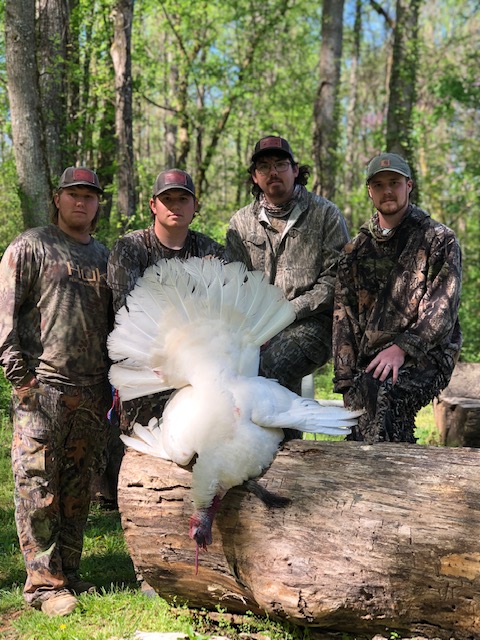
Adam Huckaby
That's up for speculation. However, scientists estimate that as many as one in every hundred turkeys could be in a smoke-phase. It's not uncommon for people to report multiple smoke-phase birds in one area simultaneously. For pure white leucistic or albino birds, the odds are against you seeing one of these rare game birds.
According to the Audubon Society, only one in 100,000 turkeys will ever be an albino. The numbers are probably close to the same for leucistic turkeys without any extra pigment in their feathers.
As we've noted, many of the pure white specimens of North American turkey likely never grow to maturity. When I interviewed the hunters who harvested the leucistic Tom in Tennessee, a hunt captured on video, they noted the sneaky bird always seemed to be on edge. They called it the most arduous hunt they'd ever had for a mature gobbler.
"This bird, he would strut, but he typically wouldn't stay full strutted very long because he wanted to peek his head up and look at his surroundings again," they told me. "So, we think this links back to him as a Jake or growing up as a poult. All the predators most likely targeted him first, rather than the others because he stuck out."
It seems that the bird's wariness paid off-he survived long enough to grow an 11-inch beard and spurs nearly 1.5 inches long. Most scientists believe many albino and white phase animals have low survival odds in the wild. A stark example is the albino alligator, which lasts about 24 hours in the wild due to the lack of camouflage and UV radiation protection. Albino animals may also be excluded from social groups. (Yes, the animal kingdom also acts like your worst middle school years.) But there have been plenty of documented cases of white pigmentation surviving for years in the wild.
Other Turkey Color Phases
Aside from the smoke-phase and white-phase varieties, some other phases wander in wild turkey populations across the country. Another odd phase is the erythristic phase. Just like albinism and leucism, it's a genetic mutation. The only difference is this one leads to more red pigments in the turkey's feathers. It gives the bird more of an orange appearance because there are few dark highlights.
On the opposite end of the spectrum is a melanistic turkey. Melanism is the exact opposite of albinism and leucism in that the animal produces an excess amount of pigment, causing a black appearance.
For some animals, melanism is common. Almost everyone has seen a black squirrel rooting for acorns before. All black turkeys are much rarer, and the difference in their plumage may be subtle. Some hunters may not even realize they shot one until they look closer. That was the case with an Oregon hunter who bagged one in 2020.
Indeed, all the odd color phases of turkey, whether white, smoke, melanistic, or otherwise, are not exactly typical. It goes without saying, however, that they all taste delicious. Suppose you see one while turkey hunting. You should buy a lotto ticket because you've just beat the odds.
This article was originally published on March 25, 2022.
For more outdoor content from Travis Smola, follow him on Twitter and check out his Geocaching and Outdoors with Travis YouTube channels.
